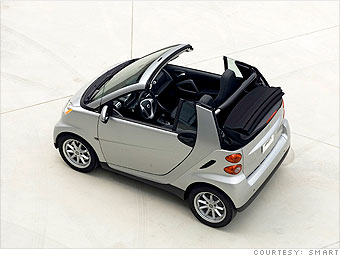
Without any fancy gasoline/electric hybrid technology, the ForTwo gets an estimated 40 miles per gallon in highway driving and an even more impressive 33 in city driving. No other car at these prices is nearly as easy on gas.
The ForTwo's small size and light weight naturally raise questions about safety. It hasn't been crash-tested by the federal government or the private Insurance Institute for Highway Safety yet, but Smart promises it will earn top crash test scores.
Until I see evidence to the contrary, I'm willing to believe them. I'm so trusting that I happily took my young son all around town in the ForTwo. (I left him at home when I tested it on the highway. I'll wait for the evidence before I try that.)
By my reasoning, the people at Smart and its parent company, Daimler, must understand that anything less than stellar crash test scores will send already nervous Americans scurrying. These days, we're used to cars of all sizes acing tests.
The ForTwo's tall shape provides obvious safety benefits of its own. Visibility is as good as in any other car's, and the bumpers of other cars and SUVs aren't aimed squarely at your head, as they are with so many other small two-seat cars.
But just so you're clear, keep one thing in mind. Front-crash test scores cannot be compared between two cars of greatly differing sizes. A big vehicle with a five-star front-crash test score will always be safer - no matter what - than a small car with the same score. It's just physics. The big vehicle will knock around whatever it hits while the smaller one will be the knockee.
NEXT: Bumpy ride
